
The Department of Microbiology caters to the diagnostic needs of VYDEHI HOSPITAL in addition to teaching programmes and research activities. Over 3, 10,000 microbiological investigations are carried out in different sections of the department namely Bacteriology, Serology, Immunology, Parasitology, Mycology. An average about 850 specimens are received per day.
We have state of the art equipment for automated equipments like Vitek 2 Compact for Sensitivity testing, BacT/ Alert 3D for Blood Culture, GeneXpert for Rapid molecular diagnosis for tuberculosis, SARS COV2 etc by real time PCR, Chemiluminescence’s immunoassay by Quidelortho to cater serology testing needs with rapid turnaround time of one hour.
All our investigations are accredited under NABL including fungal culture, in addition to all routine bacteriology, and serology investigations.
The department is actively involved in hospital Infection control activities with periodic meeting, hospital rounds and surveillance activities.
Antibiotic sensitivity testing for all isolates is carried out with the latest antibiotics as per the guidelines of clinical laboratory standards institute (CLSI). Also the internal quality control and external quality assessment scheme (EQAS, CMC Vellore, Euroimmune Germany) is maintained as per NABL guidelines. All the microbiological investigations are accredited by NABL. Periodic bacteriological surveillance of operation theatres, ICUs and CSSD are also carried out.
Undergraduate teaching for MBBS students conducted through theory lectures and practical classes as per RGUHS guidelines. Post graduate students are trained by weekly subject seminars, journal clubs and practical exercises.
The department is having experienced and qualified faculty ably supported by non-teaching staff i.e. technicians and attenders. The department has got all the infrastructural facilities like accommodation, instruments, library as per MCI requirements.
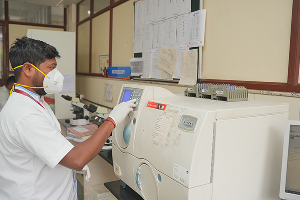
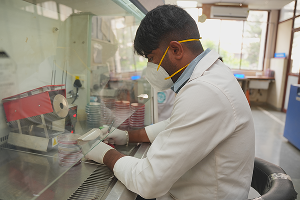
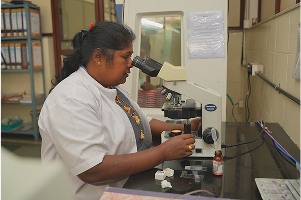
VYDEHI INSTITUTE OF MEDICAL SCIENCES & RESEARCH CENTRE, BANGALORE
DEPARTMENT OF MICROBIOLOGY
LIST OF FULL TIME TEACHING FACULTIES
Month and Year of submission of details : 05.01.2026(5th January 2026)
| SL NO | FACULTY NAME | AEBAS ATTENDID | MEDICAL REGISTRATION NO | PROFESSIONAL QUALIFICATION(S) | DEPARTMENT | DESIGNATION | NATURE OF EMPLOYMENT | TOTAL TEACHING EXP |
|---|---|---|---|---|---|---|---|---|
| 1. | DR. RANJINI C. Y | 67249217 | 86008 | MBBS, MD | MICROBIOLOGY | PROFESSOR & HOD | PERMANENT | 18 YEARS 6 MONTHS |
| 2. | DR. GIRISH N | 32854486 | 61403 | MBBS, MD | MICROBIOLOGY | PROFESSOR | PERMANENT | 22 YEARS 2 MONTHS |
| 3. | DR. LEELA RANI K | 32765713 | 86042 | MBBS, MD | MICROBIOLOGY | PROFESSOR | PERMANENT | 21 YEARS 3 MONTHS |
| 4. | DR. W. VISHNU VANDANA | 51966798 | 96502 | MBBS, MD | MICROBIOLOGY | PROFESSOR | PERMANENT | 16 YEARS 4 MONTHS |
| 5. | DR. SAATVIKA RATHOR | 99513665 | 128787 | MBBS, MD | MICROBIOLOGY | ASSISTANT PROFESSOR | PERMANENT | 5 YEARS 7 MONTHS |
| 6. | DR. ELIZABETH ANTONY | 67088691 | 101381 | MBBS, MD | MICROBIOLOGY | ASSISTANT PROFESSOR | PERMANENT | 7 YEARS 6 MONTHS |
| 7. | DR. POOJA KUMARI | 73694339 | DHL 2013 0000406 KTK | MBBS, MD | MICROBIOLOGY | ASSISTANT PROFESSOR | PERMANENT | 9 YEARS 5 MONTHS |
| 8. | DR. PRASHANTH P | 36368178 | 116670 | MBBS, MD | MICROBIOLOGY | ASSISTANT PROFESSOR | PERMANENT | 5 YEARS 7 MONTHS |
| 9. | DR. SANTOSH MACHADO | 33776143 | 85516 | MBBS, MD | MICROBIOLOGY | ASSISTANT PROFESSOR | PERMANENT | 13 YEARS 5 MONTHS |
| 10. | DR. SUPRIYA DEY | 91237729 | TRP 2012 0000006 KTK | MBBS, MD | MICROBIOLOGY | ASSISTANT PROFESSOR | PERMANENT | 7 YEARS 7 MONTHS |
| 11. | MRS. THUSHARA BALAKRISHNAN | 9505101 | N/A | B.Sc, M.Sc, PhD | MICROBIOLOGY | ASSISTANT PROFESSOR | PERMANENT | 5 YEARS 8 MONTHS |
| 12. | DR. TIKHILA AMRUTA ASHOK | 30550401 | 190179 | MBBS, MD | MICROBIOLOGY | ASSISTANT PROFESSOR | PERMANENT | 5 YEARS 4 MONTHS |
| 13. | DR. ABHISHEK BHARAWAJ N | 96184457 | 180168 | MBBS | MICROBIOLOGY | SENIOR RESIDENT | PERMANENT | 1 YEAR 1 MONTH |
| 14. | DR. VARSHINI P | 34512728 | 173437 | MBBS | MICROBIOLOGY | SENIOR RESIDENT | PERMANENT | 1 YEAR 1 MONTH |
| 15. | DR. B. SAMANTHA | 82967512 | 168503 | MBBS | MICROBIOLOGY | SENIOR RESIDENT | PERMANENT | 2 YEARS 0 MONTHS |
| 16. | DR. DHANUSH C | 42207391 | 172625 | MBBS | MICROBIOLOGY | SENIOR RESIDENT | PERMANENT | 1 YEAR 7 MONTHS |
| 17. | DR. MADALA HARSHITHA CHOWDARY | 26940904 | 191752 | MBBS | MICROBIOLOGY | SENIOR RESIDENT | PERMANENT | 0 YEARS 2 MONTHS |
| 18. | DR. SANJEEV KUMAR N | 20179223 | 160821 | MBBS | MICROBIOLOGY | SENIOR RESIDENT | PERMANENT | 0 YEARS 3 MONTHS |
| 19. | DR. JANANI NAGARAJ | 50315387 | 165708 | MBBS | MICROBIOLOGY | SENIOR RESIDENT | PERMANENT | 0 YEARS 3 MONTHS |
| 20. | DR. JOEL CHELSEA RAYEN K | 28993167 | 186649 | MBBS | MICROBIOLOGY | TUTOR | PERMANENT | 0 YEARS 10 MONTHS |
| 21. | DR. ROY CHITRA | 20089480 | 168805 | MBBS | MICROBIOLOGY | TUTOR | PERMANENT | 2 YEARS 2 MONTHS |
| 22. | MRS. M. S. SWATHI K | 42414017 | N/A | B.Sc, M.Sc | MICROBIOLOGY | TUTOR | PERMANENT | 4 YEARS 1 MONTH |
| 23. | DR. SHWETHA U R L H | 75300425 | 121152 | MBBS | MICROBIOLOGY | TUTOR | PERMANENT | 0 YEARS 1 MONTH |
Culture and sensitivity and direct microscopy of specimens received from clinical departments of Vydehi hospital are processed by Automated Vitek system.
Serological tests like Elisa and rapid tests for HIV, HBsAg, ASO, RA, CRP, WIDAL, VDRL, ANA panel by Western blot are performed.
QBC and rapid antigen detection tests for malaria parasite are also carried out in the central diagnostic laboratory.
Direct Microscopy
Culture and sensitivity
Serology tests
Done for all major infectious diseases by
Environmental surveillance
Immunology tests
Parasitology
Stool examination for ova and cysts of parasites
| Sl.No. | Name of the Article |
|---|---|
| 1. | Incubators, electrical (large) (37 ℃ ) |
| 2. | Autoclave |
| 3. | Hot air steriliser (Hot air oven) |
| 4. | Serum inspissators |
| 5. | Electrophoresis unit |
| 6. | Balance, chemical |
| 7. | Walk in Refrigerator |
| 8. | Microscope |
| 9. | Dark Ground Microscope |
| 10. | Refrigerators |
| 11. | OT Air sampler |
| 12. | EGG candler |
| 13. | Centrifuge |
| 14. | Micropipettes |
| 15. | Distilled Water Plant |
| 16. | Oil Immersion Objective |
| 17. | Anaerobic Apparatus |
| 18. | Laminar flow / Biosafety cabinet |
| 19. | VDRL Shaker |
| 20. | Computer unit |
| 21. | Overhead projector |
| 22. | Water bath (Serological) 37 degree Celsius |
| 23. | Elisa Reader and Washer |
| 24. | Binocular Microscope |
| 25. | pH Meter |
| 26. | BOD Incubator |
| 27. | Deep freezer (-20 ℃ ) |
| 28. | Electronic Balance |
| 29. | Flourscent Microscope |
| 30. | Refrigerator Centrifuge |
| 31. | Gene X pert |
| 32. | BacT Alert |
| 33. | Dark Ground Microscope |
| 34. | Air sampler |
| 35. | Elisa Reader and Washer |
| 36. | Vitek 2 compact |
| 37. | Gene X pert |
| 38. | BacT T Alert |
| 39. | VITROS 3600 |
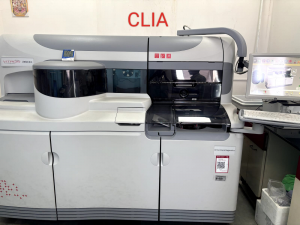
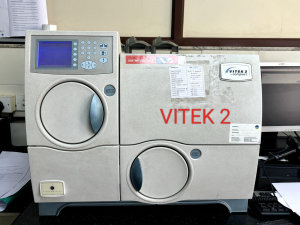
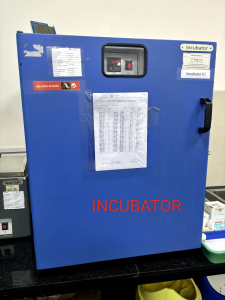

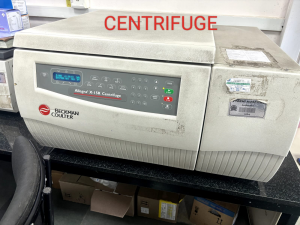

MICROBIOLOGY GOAL: The broad goal of the teaching of undergraduate students tin Microbiology is it provide an understanding of the natural history of infectious disease in order to deal with the etiology, pathogenesis, laboratory diagnosis, treatment and control of infections in the community. OBJECTIVES: KNOWLEDGE: At the end of the course, the student shall be able to:
SKILLS: At the end of the course, the student shall be able to:
INTEGRATION: The student shall understand infection diseases of national importance in relation to the clinical, therapeutic and preventive aspects. COURSE CONTENTS THEORY
Must know Morbidity and mortality data of infectious diseases prevalent in the country with reference to the National Health Programs and in the local geographic area. Desirable to know significant milestones in the history of Microbiology
TOPIC: GENERAL BACTERIOLOGY & IMMUNOLOGY (MI1.1-1.11) No of competencies – 11 No of procedures requiring certification – 1
MI1.1 describe the different causative agents of Infectious diseases, the methods used in their detection, and discuss the role of microbes in health and disease
MI1.1.1Introduction to Infectious diseases
MI1.1.2 Isolation & identification of bacteria
MI1.1.2.1 describe the classification & morphology of bacteria
MI1.1.2.2 Describe general pathogenesis and general lab diagnosis of bacterial infections MI1.1.2.3 Define, classify culture media, applications of culture media
MI1.1.2.4 Interpretation of various biochemical reactions
MI1.1.3 Introduction to virology
MI1.1.4 Introduction to mycology
MI1.1.5 Introduction to parasitology
MI1.2 Perform and identify the different causative agents of Infectious diseases by Gram Stain, ZN stain and stool routine microscopy
MI1.3 Describe the epidemiological basis of common infectious diseases
MI1.4 Classify and describe the different methods of sterilization and disinfection. Discuss the application of the different methods in the laboratory, in clinical and surgical practice MI1.4.1Define: Sterilization, disinfection, asepsis, antiseptics, and decontamination.
MI1.5 Choose the most appropriate method of sterilization and disinfection to be used in specific situations in the laboratory, in clinical and surgical practice
MI1.5.1 classify the medical devices using Spaulding’s classification
MI1.6 Describe the mechanisms of drug resistance, and the methods of antimicrobial Susceptibility testing and monitoring of antimicrobial therapy
MI1.6.1 describe the bacterial genetic structures
MI1.6.2 Define drug resistance, List out various mechanisms of antibacterial resistance. MRSA, VRE, ESBL, MBL etc
MI1.7 Describe the immunological mechanisms in health
MI1.7.1 Immunity
MI1.7.2 Immune system – Describe structure and functions of immune system
MI1.7.3 Antigen & Immunoglobulin’s
MI1.7.4 Complement system
MI1.7.5 Antigen antibody reactions
MI1.8 describe the mechanisms of immunity and response of the host immune system to Infections
MI1.8.1 Define & classify Immune response
MI1.8.2 Describe cell mediated immune response
MI1.9 Discuss the immunological basis of vaccines and describe the Universal Immunisation schedule
MI1.10 Describe the immunological mechanisms in immunological disorder (Hypersensitivity, autoimmune disorders and immunodeficiency states) and discuss The laboratory methods used in detection.
MI1.10.1 Hypersensitivity
MI1.10.2 Autoimmunity
MI1.10.3 Immunodeficiency
MI1.11 Describe the immunological mechanisms of transplantation and tumour immunity
Tumour immunity
TOPIC – CVS & BLOOD (MI2.1-2.7) No of competencies- 7 No of procedures requiring certification -NIL
MI2.1 Describe the etiologic agents in rheumatic fever and their diagnosis Rheumatic fever
MI2.2 Describe the classification etio-pathogenesis, clinical features and discuss the diagnostic modalities of Infective endocarditis
MI2.3 Identify the microbial agents causing Rheumatic Heart Disease & infective Endocarditis
MI2.3.1 Define sepsis, septicaemia, bacteraemia, fungemia, viremia, parasitemia
MI2.4 List the common microbial agents causing anemia. Describe the morphology, mode of infection and discuss the pathogenesis, clinical course, diagnosis and prevention and treatment of the common microbial agents causing Anemia
MI2.5 Describe the etio- pathogenesis and discuss the clinical evolution and the laboratory diagnosis of kalaazar, malaria, filariasis and other common parasites prevalent in India
Introduction
MI2.5.1 Malaria
MI2.5.2 Leishmania
MI2.5.3 Trypanosoma
MI2.5.4 Filarial worm
MI2.5.5 Schistosomes
MI2.6 Identify the causative agent of malaria and filariasis
MI2.7 Describe the epidemiology, the etio- pathogenesis, evolution complications, opportunistic infections, diagnosis, prevention and the principles of management of HIV
MI2.7.1 Describe morphology, epidemiology, pathogenesis of HIV
MI2.7.2 Opportunistic infections in AIDS
MI2.7.3 Describe the immunological abnormalities in HIV infection
MI2.7.4 Discuss NACO guidelines, strategies, pre-test counseling, Post- test counseling
MI2.7.5 Describe various modes of transmission of HIV
MI2.7.6 Describe prophylactic measures in preventing HIV Transmission Standard precautions, spill management etc
TOPIC: GASTROINTESTINAL & HEAPATOBILIARY SYSTEM (MI3.1-3.8) No of competencies 8 No of procedures requiring certification – NIL
MI3.1. Enumerate the microbial agents causing diarrhea and dysentery. Describe the epidemiology, morphology, pathogenesis, clinical features and diagnostic modalities of these agents.
MI3.1.1-Introduction of gastrointestinal infections
MI3.1.2 Epidemiology, pathogenesis, laboratory diagnosis of diarrheagenic E.coli,
MI3.1.3 Epidemiology, pathogenesis, clinical features, complications, Laboratory diagnosis, treatment & prophylaxis of Cholera
MI3.1.4 Antibiotic Associated Diarrhoea – Clostridium difficile
MI3.1.5 Viral gastroenteritis etiological agents, epidemiology, pathogenesis, clinical features and laboratory diagnosis – Rota, Astro, Noro
MI3.1.6 Bacillary dysentery Define dysentery etiological agents, pathogenesis, clinical features and laboratory diagnosis of bacillary dysentery -Shigella.Y.enterocolitica
MI3.1.7 Amoebic dysentery Discuss the morphology, life cycle, mode of transmission, pathogenesis, clinical features, complications and laboratory diagnosis of Amoebic dysentery difference between amoebic and bacillary dysentery – E.histolytica
MI3.1.8 Etiological agents, pathogenesis, clinical manifestations and laboratory diagnosis of Diarrhoea in immunocompromised host- Giardiasis Cryptosporidium, Cyclospora, Isospora, Giardia.
MI3.1.9 Soil transmitted helminthic infections- Ascaris, Enterobius, Trichuris trichuira
MI3.2 Identify the common microbial agents causing diarrhoea and dysentery
MI3.3 Enteric fever Describe the enteric fever pathogens and discuss the evaluation of clinical course and the laboratory diagnosis of diseases caused by them
MI3.4 Identify the different modalities for diagnosis of Enteric fever, choose the appropriate test related to the duration of illness.
MI3.5 Food poisoning Enumerate the causative agents of food poisoning and discuss the pathogenesis, clinical course and laboratory diagnosis
MI 3.6 Acid Peptic disease Describe the etiopathogenesis of Acid peptic disease and the clinical course. Discus the diagnosis and management of the causative agent of Acid peptic disease.
MI3.7 Viral hepatitis describes the epidemiology, the etio- pathogenesis and discusses the viral markers in the evolution of viral hepatitis. Discuss the modalities in the diagnosis and prevention of viral hepatitis
MI3.7.1 Discuss the pathogenesis, clinical manifestations, complications and laboratory diagnosis, treatment and prophylaxis of enterically transmitted viral hepatitis Hepatitis A & E
MI3.7.2 Discuss the pathogenesis, clinical features, laboratory diagnosis treatment and prophylaxis of parenteral transmitted viral hepatitis -Hepatitis B
MI3.7.3 Discuss the pathogenesis, clinical features, laboratory diagnosis treatment and prophylaxis of parenteral transmitted viral hepatitis C & D
TOPIC: INFECTIONS OF SKIN & MUSCULOSKELETAL SYSTEM (MI4.1-4.3) No of competencies – 3 No of procedures requiring certification – NIL
MI4.1 – Enumerate the microbial agents causing anaerobic infections. Describe the etiopathogenesis, clinical course and discuss the laboratory diagnosis of anaerobic infections
MI4.1.1 Introduction to anaerobic infections
MI4.1.2 Discuss the pathogenesis, clinical features, laboratory diagnosis, treatment and prophylaxis of Tetanus.
MI4.1.3 Discuss the pathogenesis, clinical features, laboratory diagnosis and treatment of botulism.
MI4.1.4 Discuss the etiopathogenesis, clinical features, laboratory diagnosis and treatment of pseudomembranous colitis.
MI4.1.5 Classification, diseases, laboratory diagnosis & treatment of infections caused by non sporing anaerobes.
MI4.1.6 Discuss the pathogenesis, clinical features, lab diagnosis, treatment and prophylaxis of Actinomycosis & nocardiosis
MI4.2 Describe the etiopathogenesis, clinical course and discuss the laboratory diagnosis of bone & joint infections
MI4.3 Describe the etiopathogenesis of infections of skin and soft tissue and discuss the clinical course and the laboratory diagnosis.
MI4.3.1 Introduction to Skin & Soft Tissue Infections
MI4.3.2
MI4.3.3 Enumerate viruses causing skin and soft tissue lesions. Discuss in detail Herpes viruses, pathogenesis, clinical features, laboratory diagnosis, treatment and prophylaxis.
MI4.3.3a Viral exanthematous infections – Measles, Rubella, (Coxsackie, Pox, HPV, Molluscum, Hand foot mouth Disease)
MI4.3.4 List fungi causing superficial fungal diseases. Describe their clinical features, laboratory diagnosis, treatment and prophylaxis – Tinea versicolor, piedra, tinea nigra, dermatophytoses, Mucocutaneous candidiasis.
MI4.3.5 subcutaneous mycosis – list the fungi causing subcutaneous mycosis. Describe the clinical features, laboratory diagnosis and treatment of subcutaneous mycosis.- Sporotrichosis, Chromoblastomycoses, Rhinosporidiosis, entamophthoromycoses, mycetoma.
MI4.3.6 Enumerate the tissue nematode parasites causing skin and soft tissue lesions with their clinical course and laboratory diagnosis- Filariasis, Onchocerca, Loa loa, Mansonella, Dracunculus, Trichinella and Larva migrans.
MI4.3.7 Describe the pathogenesis, clinical course and laboratory diagnosis of Diabetic foot & cellulitis- Streptococcus & others.
MI4.3.8 Describe the pathogenesis, clinical course and laboratory diagnosis of cutaneous Anthrax.
TOPIC: CENTRAL NERVOUS SYSTEM INFECTIONS – (MI5.1-5.3) No of competencies: (3) No of procedures that require certification: NIL
MI5.1 Describe the etiopathogenesis, clinical course and discuss the laboratory diagnosis of meningitis.
MI5.1.1 Describe normal structure of CNS and normal protective mechanisms.
MI5.1.2 Define meningitis
MI5.1.3 Classify meningitis based on age group and duration
MI5.1.4. Enumerate the causative agents of meningitis and classify them based on age group affected, duration of disease and immune status.
MI5.1.5. Describe general pathogenesis and clinical features of meningitis
MI5.1.6. Discuss the general approach to diagnosis of meningitis
MI5.1.7. Describe pathogenesis, lab diagnosis, prevention and treatment of meningococcal meningitis
MI5.1.8. Describe pathogenesis, lab diagnosis, prevention and treatment of pneumococcal meningitis
MI5.1.9. Describe pathogenesis, lab diagnosis, prevention and treatment of meningitis caused by Streptococcus agalactiae
MI5.1.10. Describe pathogenesis, lab diagnosis, prevention and treatment of meningitis caused by Haemophilus influenzae
MI5.1.11. Describe pathogenesis, lab diagnosis, prevention and treatment of Listeria meningitis
MI5.1.12. Describe pathogenesis, lab diagnosis, prevention and treatment of gram negative bacterial meningitis
MI5.1.13. Describe pathogenesis, lab diagnosis, prevention and treatment of tubercular meningitis
MI5.1.14. Describe pathogenesis, lab diagnosis, prevention and treatment of meningitis caused by spirochetes
MI5.1.15. Describe pathogenesis, lab diagnosis, prevention and treatment of viral meningitis caused by Herpes viruses, Enteroviruses, Mumpsvirus, etc
MI5.1.16. Describe pathogenesis, lab diagnosis, prevention and treatment of meningitis caused by fungi – Cryptococcus neoformans, Candida Spp., Coccidioides, Histoplasma, etc.,
MI5.2 Describe the etiopathogenesis, clinical course and discuss the laboratory diagnosis of encephalitis
MI5.2.1. Define: Encephalitis
MI5.2.2. Classify Encephalitis
MI5.2.3. Enumerate the causative agents of Encephalitis
MI5.2.4. Describe general pathogenesis of encephalitis
MI5.2.5. Describe the clinical presentation of Encephalitis
MI5.2.6. Discuss the approach to diagnosis of viral Encephalitis
MI5.2.7. Describe morphology of polio virus. Describe pathogenesis, clinical features, lab diagnosis and prevention of poliomyelitis
MI5.2.8. Describe morphology of rabies virus. Describe pathogenesis, clinical features, lab diagnosis and prevention of rabies
MI5.2.9. Describe etiology, pathogenesis, clinical features, lab diagnosis and prevention of slow viral infections
MI5.2.10. Discuss the etiopathogenesis, clinical features and approach to diagnosis of parasitic meningitis and Encephalitis
MI5.2.11. Discuss the etiopathogenesis, clinical features and approach to diagnosis of brain abscess
MI5.2.12. Discuss the etiopathogenesis, clinical features and approach to diagnosis of cystic brain lesion- neurocysticercosis, hydatid disease of brain
MI5.3 Identify the microbial agents causing meningitis
MI5.3.1. Analyse clinical features, interpret laboratory test results provided to diagnose the clinical condition and identify the causative microorganism.
MI5.3.2 Describe normal ranges of common CSF parameters
MI5.3.3. Interpret abnormal results of CSF analysis report provided.
MI5.3.4 Demonstrate CSF collection in a mannequin
TOPIC: RESPIRATORY TRACT INFECTIONS MI6.1-6.3 No of Competency-3 No of procedures require Certification-2 Competency
MI6.1 Describe the etio-pathogenesis, laboratory diagnosis and prevention of Infections of upper and lower respiratory tract
MI6.1.1 Describe the structure respiratory system and role of immunity in respiratory system.
MI6.1.2 Discuss the etiological agents, pathogenesis, epidemiology clinical features, complications and laboratory diagnosis of rhinitis
MI6.1.3 Discuss the classification, etiological agents, pathogenesis, epidemiology clinical features, complications and laboratory diagnosis of otitis
MI6.1.4 Discuss the etiological agents, pathogenesis, epidemiology clinical features, complications and laboratory diagnosis of sinusitis
MI6.1.5 Discuss the etiological agents, pathogenesis, epidemiology clinical features, complications and laboratory diagnosis of pharyngitis, tonsillitis
MI6.1.6 Discuss the etiological agents, pathogenesis, epidemiology clinical features, complications and laboratory diagnosis of laryngitis, bronchitis, bronchiolitis
MI6.1.7 Define & classify pneumonia. Enumerate the etiological agents of pneumonia general laboratory diagnosis and prophylaxis of pneumonia
MI6.1.8 Discuss pathogenesis, epidemiology clinical features, complications and laboratory diagnosis of community acquired pneumonia- pneumococci
MI6.1.9 Enumerate the etiological agents, pathogenesis, epidemiology clinical features, complications and laboratory diagnosis of hospital acquired pneumonia-Klebsiella, Staphylococci, Legionella
MI6.1.10 Enumerate the etiological agents, pathogenesis, epidemiology clinical features, complications and laboratory diagnosis treatment and prophylaxis of ventilator associated pneumonia- Acinetobacter
MI6.1.11 Enumerate the etiological agents, pathogenesis, epidemiology clinical features, complications and laboratory diagnosis of atypical pneumonia- Mycoplasma, Chlamydia.
MI6.1.12 Enumerate the etiological agents, pathogenesis, epidemiology clinical features, complications and laboratory diagnosis of viral respiratory infections – Adeno, RSV, EBV.
MI6.1.13 Enumerate the etiological agents, pathogenesis, epidemiology clinical features, complications and laboratory diagnosis of viral pneumonia – Influenza virus, SARS -corona
MI6.1.14 Enumerate the etiological agents, pathogenesis, epidemiology clinical features, complications and laboratory diagnosis of pneumonia in immunocompromised host-Pneumocystis jirovecii, CMV
MI6.1.15 Describe the epidemiology, mode of transmission, pathogenesis, clinical features complications, laboratory diagnosis, treatment and prophylaxis of pulmonary tuberculosis
MI6.1.16 Discuss the importance of MDR TB, RNTCP HIV TB co-infection
MI6.1.17 Define and classify the atypical mycobacteria discuss the pathogenesis, clinical features, complications and treatment of pulmonary atypical mycobacterial infection
MI6.1.18 Discuss the general characters of dimorphic fungi. Discuss the mode of transmission, pathogenesis, clinical features, complications and laboratory diagnosis of pulmonary mycosis-Histoplasma, Coccidioides, Blastomyces, Paracoccidiodies.
MI6.1.19 Discuss mode of transmission, pathogenesis, clinical features laboratory diagnosis of aspergillosis
MI6.1.20 Parasites affecting lung – Paragonimus westermanii (non-core), Loefflers syndrome, amoebic lung abscess
MI6.1.21 Discuss the immunoprophylaxis for respiratory tract infections
MI6.2 Identify the common etiologic agents of upper respiratory tract infections (Gram Stain)
MI6.2.1 Describe the method of sample collection and transportation
MI6.2.2 Explain the steps of gram’s staining procedure
MI6.2.3 Do the grams staining procedure
MI6.2.4 Observe the stained smear
MI6.2.5 Interpret and Report the staining results
MI6.3 Identify the common etiologic agents of lower respiratory tract infections (Gram Stain & Acid fast stain)
MI6.3.1 Enumerate the organisms causing LRTI
MI6.3.2 Describe the method of sample collection
MI6.3.3 Recap the Gram’s staining procedure and repetition
MI6.3.4 Explain the Acidfast staining procedure
MI6.3.5 Perform the Acid fast staining procedure
MI6.3.6 Interpret and Report the staining results
TOPIC: – GENITOURINARY & SEXUALLY TRANSMITTED INFECTIONS (MI7.1-7.3) No of competencies – 3 No of procedures requiring certification – NIL
MI7.1 Describe the etiopathogenesis and discuss the laboratory diagnosis of infections of genitourinary system
MI7.1.1 Describe the normal anatomy and innate defense mechanisms in the male and female genital tract
MI7.1.2 Enumerate the various infections of genitourinary tract
MI7.1.3 Describe the etiology and pathogenesis of genitourinary tract infections in general.
MI7.1.4 Discuss the clinical features, sample collection and laboratory diagnosis of genitourinary infections in general
MI7.1.5 Discuss the effect/ complications of genitourinary infections in pregnancy (Maternal & fetal)
MI7.2 Describe the etiopathogenesis and discuss the laboratory diagnosis of Sexually Transmitted Infections. Recommend preventive measures
MI7.2.1 Enumerate the bacterial, viral, fungal and parasitic agents causing Sexually Transmitted infections
MI7.2.2 Describe the pathogenesis, clinical features, laboratory diagnosis and treatment of pathogens causing ulcerative lesions in the genital tract (Syphilis, Haemophilus ducreyi, LGV, Calymmatobacterium granulomatis, Herpes Virus)
MI7.2.3 Describe the pathogenesis, clinical features, laboratory diagnosis and treatment of pathogens causing Urethral syndrome/ white discharge per vagina (Gonococci, Candida spp, Trichomonas vaginalis, Bacterial vaginosis)
MI7.2.4 Describe the pathogenesis, clinical features, laboratory diagnosis and treatment of Mycoplasma spp
MI7.2.5 Describe non gonococcal urethritis. Enumerate the agents causing the same
MI7.2.6 Differentiate between bacterial vaginosis & bacterial vaginitis
MI7.2.7 Discuss the various measure for prevention of Sexually Transmitted infections
MI7.2.8 Discuss the importance of confidentiality in reporting Sexually transmitted diseases
MI7.2.9 Discuss the role of counselling in management of Sexually transmitted diseases
MI7.2.10 Enumerate the pathogens causing congenital infections. Discuss the pathogenesis, lab diagnosis, prophylaxis, prevention and treatment of these infections.
MI7.3 Describe the etiopathogenesis, clinical features, the appropriate method for specimen collection and discuss the laboratory diagnosis of Urinary tract infections
MI7.3.1 Describe the normal anatomy, physiology and Innate defense mechanisms of the urinary tract
MI7.3.2 Mention the types of Urinary tract infections (upper and lower)
MI7.3.3 Mention the causative agents of urinary tract infection
MI7.3.4 Enumerate the predisposing factors in Urinary Tract infections
MI7.3.5 Discuss the pathogenesis of urinary tract infection
MI7.3.6 Discuss the clinical features of Urinary tract infections (Difference between upper and lower urinary tract infections)
MI7.3.7 Describe the methods of collection of urine from infant, adult men/women, and catheterized patients
MI7.3.8 Discuss the concept of significant bacteriuria
MI7.3.9 Discuss about asymptomatic bacteriuria & conditions these are seen
MI7.3.10 Describe about sterile pyuria and enumerate the disease causing sterile pyuria
MI7.3.11 Define Catheter associated urinary tract infection. Enumerate the predisposing factors, prevention, diagnosis and treatment of CAUTI
MI7.3.12 Discuss the laboratory diagnosis and treatment of Urinary tract infections
TOPIC- ZOONOTIC DISEASES & MISCELLANEOUS (MI8.1-8.16) No of competencies -16 No of procedures require certification-1
MI8.1 Enumerate the microbial agents and their vectors causing Zoonotic diseases. Describe the morphology, mode of transmission, pathogenesis and discuss the clinical course laboratory diagnosis and prevention Introduction -Define zoonotic infections. Enumerate organisms causing zoonotic infections in man and the mode of transmission/vectors transmitting them
MI8.1.1 Anthrax-Describe the morphology, mode of transmission, pathogenesis and discuss the clinical course laboratory diagnosis and prevention of Anthrax
MI8.1.2 Plague- Describe the morphology, mode of transmission, pathogenesis and discuss the clinical course laboratory diagnosis and prevention plague
MI8.1.3 Brucellosis-Describe the morphology, mode of transmission, pathogenesis and discuss the clinical course laboratory diagnosis and prevention brucellosis
MI8.1.4 Leptospirosis-Describe the morphology, mode of transmission, pathogenesis and discuss the clinical course laboratory diagnosis and prevention leptospirosis
MI8.1.5 Rickettsia- Describe the morphology, mode of transmission, pathogenesis and discuss the clinical course laboratory diagnosis and prevention Rickettsial and miscellaneous zoonoses
MI8.1.6 Arboviral-Describe the morphology, mode of transmission, pathogenesis and discuss the clinical course laboratory diagnosis and prevention of Arboviral infections-Dengue, chikungunya, KFD
MI8.1.7 Toxoplasma & Balantidium-Describe the morphology, mode of transmission, pathogenesis and discuss the clinical course laboratory diagnosis and prevention of toxoplasmosis & balantidiasis
MI1.8.8 Taeniasis-Describe the morphology, mode of transmission, pathogenesis and discuss the clinical course laboratory diagnosis and prevention of taeniasis
MI1.8.9 Hydatid disease-Describe the morphology, mode of transmission, pathogenesis and discuss the clinical course laboratory diagnosis and prevention of hydatid cyst disease
MI1.8.10 Rabies-Describe morphology of Rabies virus. Describe pathogenesis, clinical features, lab diagnosis and prevention of rabies
MI8.2 Describe the etio-pathogenesis of Opportunistic Infections (OI) and discuss the factors contributing to the occurrence of OI, and the laboratory diagnosis
Viral agents
Fungal OI
Parasitic OI
MI8.3 Describe the role of oncogenic viruses in the evolution of virus associated malignancy
MI8.4 Describe the etiologic agents of Emerging Infectious diseases.
MI8.5 Define Healthcare Associated Infections (HAI) and enumerate the types. Discuss the factors that contribute to the development of HAI and the methods for prevention
MI8.6 Describe the basics of PANDEMIC MANAGEMENT (Infection control)
MI8.7 Demonstrate Pandemic management (Infection control) practices and use of Personal Protective Equipment (PPE) MI8.8 Describe the methods used and significance of assessing the microbial contamination of food, water and air
MI8.9 Discuss the appropriate method of collection of samples in the performance of laboratory tests in the detection of microbial agents causing Pandemic (infectious diseases)
MI8.10 Demonstrate the appropriate method of collection of samples in the performance of laboratory tests in the detection of microbial agents causing Pandemic (Infectious diseases)
MI8.11 Demonstrate respect for patient samples sent to the laboratory for performance of laboratory tests in the detection of microbial agents causing Infectious diseases
MI8.12 Discuss confidentiality pertaining to patient identity in laboratory results
MI8.13 Choose the appropriate laboratory test in the diagnosis of the infectious disease
MI8.14 Demonstrate confidentiality pertaining to patient identity in laboratory results
MI8.15 Choose and Interpret the results of the laboratory tests used in diagnosis of the infectious diseases
MI8.16 Describe the National Health Programs in the prevention of common infectious disease (for information purpose only as taught in CM)
OSPE
AETCOM
SKILLS Must know
TEACHING HOURS THEORY No. of hours of teaching: 120 hrs.
PRACTICAL EXERCISES IN MICROBIOLOGY: The students would perform the following procedures:
MICROSCOPE
STERILIZATION Principle, Uses and Demonstration of common sterilization equipment namely, Autoclave, Hot Air Oven, Serum Inspissators, Arnold Steriliser, Filters. III. CULTURE MEDIA: Classification of culture media, Principles, main ingredients and uses of common culture media. Namely-Peptone water, Nutrient Broth, Nutrient Agar, Blood Agar, Chocolate agar, Mac Conkey, Wilson Blair, TCBS, LJ, Potassium telluride, Dorset egg, Loeffler’s serum slope, RCM, milk agar, Selenite F-broth, Blood culture broth. Media for Biochemical reaction – Sugar Fermentation, Urease, Citrate, Indole Media with growth of common organisms for demonstration namely Staphylococci, C. diphtheria, Mycobacterium tuberculosis, Salmonella on W.B., Vibrio on TCBS, Mac-Conkey with LF & NLF, Milk Agar with Staphylococci, Proteus on Nutrient Agar. Antibiotic sensitivity – methods & principles. STAINING AND HANGING DROP: 1) Demonstration of motility by hanging drops method. 2) Gram Stain 3) ZN Stain PARASITOLOGY: Examination of faeces for helminthic Eggs, (Round worm, hook Worm, Whip Worm, H. nana) APPLIED BACTERIOLOGY: Demonstration of specimen collection. Growth on appropriate media Biochemical reactions. Appropriate special tests for the lab-diagnosis of common infectious diseases. Namely:
VII. DEMONSTRATION OF SEROLOGICAL TEST: Widal Test, VDRL, ELISA. VIII. DEMONSTRATION OF FUNGUS: Growth, Slide mounts of common fungi, Candida, Aspergillus, Mucor, Rhizopus, Penicillium, Dermatophytes (one or two) USES OF LABORATORY ANIMALS: Rabbit, Guinea Pig & Mouse DEMONSTRATION OF SLIDES & INSTRUMENTS MEDIA & SPECIMENS (DEMONSTRATION) The following procedures are only for demonstration. Students will interpret results, but need not perform the procedure of tests. Serological demonstration of – WIDAL, VDRL. Haemagglutination, Haemagglutination inhibition, Complement fixation test, Viral Haemagglutination, ELISA. XII. INTEGRATED TEACHING:
The following materials are to be procured for the conduct of practical classes.
SLIDES
MEDIA
Without Growth
With Growth
List of Instruments
List of Specimens
TERM WISE DISTRIBUTION OF THEORY PORTIONS 3rd TERM: GENERAL BACTERIOLOGY, IMMUNOLOGY & SYSTEMATIC BACTERIOLOGY (COCCI) 4th TERM: REMAINING SYSTEMATIC BACTERIOLOGY & PROTOZOOLOGY 5th TERM: HELMINTHOLOGY, VIROLOGY, MYCOLOGY & APPLIED MICROBIOLOGY. RECOMMENDED BOOKS (Recent Editions)
REFERENCE BOOKS:
LEVEL – I
LEVEL – II
LEVEL III
DIAGNOSIS MICROBIOLOGY
Competencies: The undergraduate learner demonstrates:
Broad subject specific objectives: At the end of the course the student will be able to:
Skills: At the end of the course the student shall be able to:
Integration: The teaching should be aligned and integrated horizontally and vertically in organ systems with emphasis on host-microbe-environment interactions and their alterations in disease and clinical correlations so as to provide an overall understanding of the etiological agents, their laboratory diagnosis and prevention.
Teaching hours
Subject | Lectures | SGL | SDL | Total |
Microbiology | 70 | 135 | 10 | 215 |
| Sl.No | Authors 1st Author 2nd Author Or Corresponding author | Title of the paper | Whether published in International National state/ Institutional Journals | Details of Indexing | Citation of the journal | Date Of Publication | Page No. Volume: ISSN No: |
|---|---|---|---|---|---|---|---|
| 1. | Nitya Tirumala, Leela Rani | Bacteriological profile of Diabetic foot ulcer with special reference to Biofilm formation open access original article Cureus 2024. | International | CUREUS | Bacteriological profile of Diabetic foot ulcer with special reference to Biofilm formation. 2024. | 2024 | |
| 2. | C.Y Ranjini, Nirupama.D.N, Helen Thomas, Mohan Thomas Nainan etal | Comparative evaluation of antifungal activity of sodium hypochlorite, calcium hypochlorite, modified salt solution associated with passive ultrasonic irrigation against candida albicans-An in vitro study | International | Scopus | J Conserv Dent Endod. Doi: 10.4103/ JCDE.JCDE_211_23. Epub 2024 Feb 8. PMID: 38463475; PMCID: PMC10923231. | 2024 | |
| 3. | Leela Rani K | Reducing hospital acquired infections and improving the rational use of antibiotics in a tertiary care hospital in Bangalore | International | Index copernicus | International journal of medical microbiology and tropical diseases. 2022, 8(3)210-218. | 2022 | |
| 4. | Thushara Balakrishnan, Girish N. | Multidrug resistant tuberculosis detection by phenotypic method in treatment naive pulmonary tuberculosis patients | National | Scopus | Citation Index ISSN-2395-9468 (print) 2395- 1791 (electronic) | Apr-June 2022 | |
| 5. | Reenu. S.P, Girish Narayana Swamy, Ramesh Kumar Kushwaha | Bacterial urinary tract infection in diabetes patients and evaluation for multidrug resistant organisms | International | Index copernicus | Citation Index ISSN-2581-4753 (print) 2581- 4651 (electronic) | Apr-June 2022 | |
| 6. | Supriya Dey, Girish Narayanaswamy | Isolation of Salmonella Typhi from pleural empyema necessitans: A case report from a tertiary care hospital, Bangalore, Karnataka | International | Pubmed | Citation Index ISSN-2581-4753 (print) 2581- 4651 (electronic) | Apr-June 2022 | |
| 7. | Teena Thomas, Gachimath Supriya, Kumari Pooja | Arcanobacterium haemolyticum: A case series. | International | Pubmed index, | PMID: 33375896. Doi: 10.1177/00494755221097506,PMID | Apr 2022 | |
| 8. | Leela Rani K | Nosocomial blood stream infection and the emerging carbapenen resistant pathogen Ralstonia mannitolytica -A case series | International | Index copernicus | International journal of microbiology and mycology 13(5)1-7 | November 2021 | |
| 9. | Thushara Balakrishnan, Girish N. | Primary drug resistance among Mycobacterium tuberculosis isolates from treatment naive pulmonary tuberculosis patients in relation to their socioeconomic status. July-Dec 2021 | National | Scopus | Citation Index ISSN-2395-9470(print) 2395- 1793(electronic) | July-Dec 2021 | |
| 10. | Dr Elizabeth Antony, Dr Sreedhara HG | Study On Association Between Nasopharyngeal Colonizers and Middle Ear Pathogens in Chronic Suppurative Otitis Media | International | Pubmed | PUBMED-National Library of Medicine ID-101739732 | July-August 2021 | |
| 11. | Elizabeth Antony*, Hg. Sreedhara and L. Gayathree | Study of Aerobic Bacterial Profile in Chronic Suppurative Otitis Media and their Antibiotic Susceptibility Pattern | International | Pubmed | SSN: 2319-7706 Volume 10 Number 08 | 2021 | |
| 12. | Elizabeth Antony*, Hg. Sreedhara and L. Gayathree | A Study on Mupirocin and Clindamycin Resistance in Clinical Isolates of Methicillin Resistant Staphylococcus Aureus from A Tertiary Care Hospital Hassan | International | Pubmed | PUBMED-National Library of Medicine ID-101739732 | July-August 2021 | |
| 13. | Priya Datta, Shiwani Sharma, Varsha Gupta, Pooja Kumari, Chander J, | A study of risk factors and outcome of hospital acquired infection(HAI) caused by extremely drug resistant gram negative bacilli in ICU patients from a tertiary care centre | International | Scopus index | IJPPR, | Jan 2021 | |
| 14. | W. V. Vandana, K Dinesh, Sofiya Rabye | Intestinal Colonization with Multidrug resistant Enterobacteriaceae in a healthy adult population | International | Index copernicus | DOAJ ,Research Gate, Journal factor, Scribed, Unifactor, Science Centred Vol-13,No.1,p-18-25, | 2021 |
The department has got microbiology museum which has got all the display as per MCI regulations i.e. 25 portraits of scientists, 30 charts, 7 models, 20 culture media, 10 instruments and 10 fungal cultures. It is located in the newly established Vydehi Discovery museum (VIDA). The detailed information of all the exhibits is catalogued in an electronic touch screen device which can be accessed by students visiting the museum. The microscopic appearance of the specimens on the slide can be visualized on a large wall mounted display unit connected to the binocular microscope. Electrically illuminated culture media display chamber and three-dimensional model of HIV and rabies virus are worthy of mention. With this our museum is second to none
The department library is well stocked with the latest editions of text books for undergraduates and post graduates. More than 100 reference books for post graduates including the Topley Wilson, Murray, Prescott etc are available.
COMPLETED PROJECTS
PG DISSERTATION ON GOING PROJECT
Topic: Colonization and subsequent infection with carbapenem resistant enterobacteriaceae among ICU patients in a tertiary care teaching hospital.
Central Diagnostic Laboratory (CDL) is accredited by National Accreditation Board for Testing and Calibration Laboratories (NABL).
